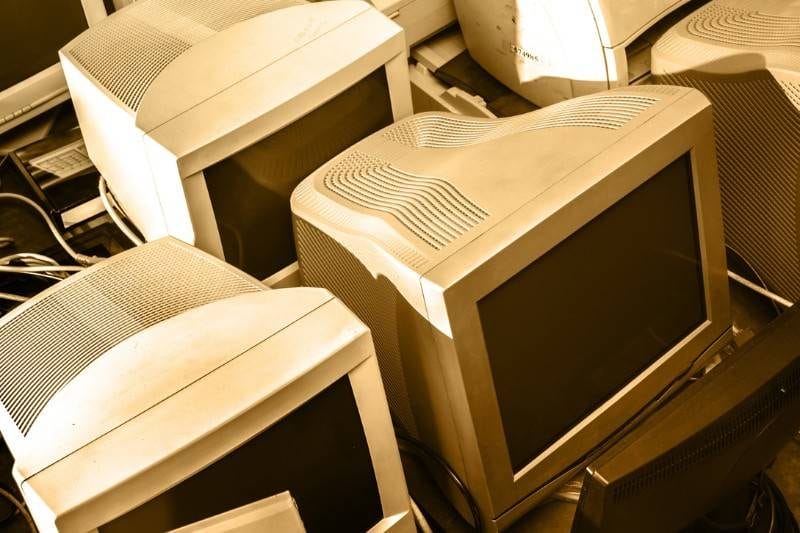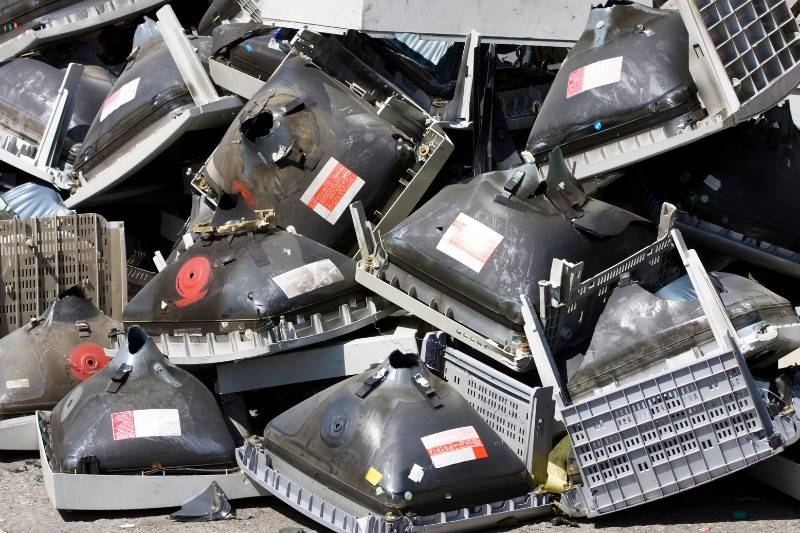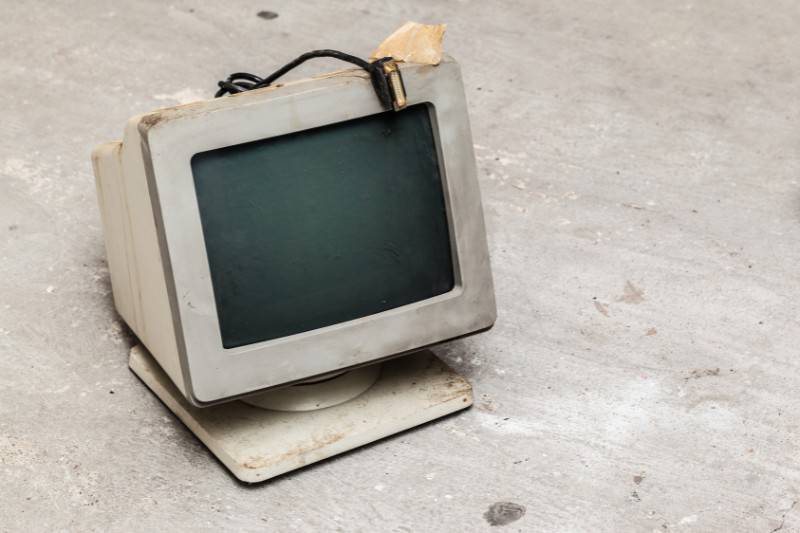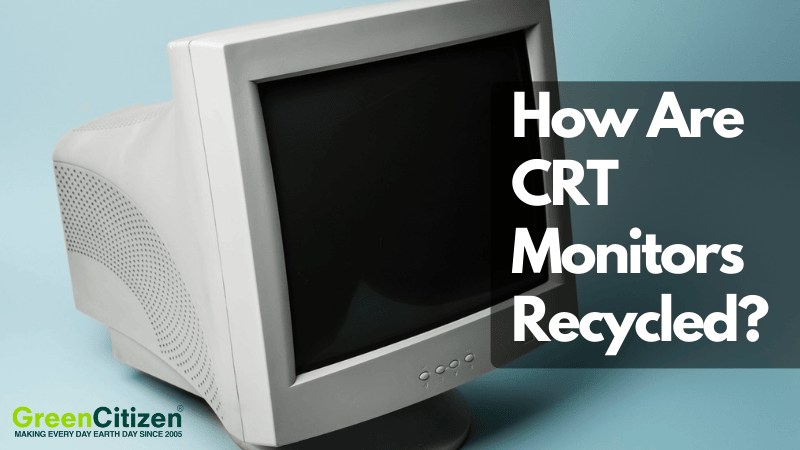CRT monitor recycling isn’t just about clearing space — it’s about preventing serious environmental harm. These heavy, outdated screens contain leaded glass, toxic phosphor dust, and other hazardous materials that make CRT monitor disposal one of the most challenging aspects of electronic waste recycling.
Improper disposal can lead to soil and groundwater contamination, which is why CRT monitors require specialized recycling methods. Certified facilities carefully dismantle each unit to recover recyclable materials like copper wiring, circuit boards, and glass, while safely managing toxic components.
This guide explains how CRT monitors are recycled step-by-step, why they require this level of care, and where you can find responsible CRT recycling options. Understanding this process helps reduce e-waste and keeps harmful substances out of landfills.
Key Takeaway: How to Recycle CRT Monitors Responsibly
CRT monitors can’t go in the trash or standard recycling bins because they contain hazardous materials like leaded glass and toxic phosphor. To recycle CRT monitors safely, bring them to certified e-waste facilities that specialize in dismantling, material recovery, and preventing environmental contamination through proper hazardous waste handling.
Can You Recycle CRT Monitors?
Yes, CRT monitors can be recycled — but not through regular curbside recycling programs. These bulky devices contain hazardous materials, including leaded glass, mercury, and toxic phosphor coatings, which require specialized handling at certified e-waste recycling facilities.
Recycling CRT monitors is not only possible — it’s essential.
Proper recycling prevents hazardous substances from leaching into the environment and allows valuable materials like copper, steel, and glass to be recovered and reused. Specialized recyclers use dismantling processes designed to safely separate these components while complying with environmental regulations like the Resource Conservation and Recovery Act (RCRA).
Most electronics recycling centers, hazardous waste programs, and certified e-waste facilities accept CRT monitors for recycling. However, it’s important to verify that your chosen recycler follows strict environmental standards for handling CRT glass and other toxic components.
By recycling your CRT monitor responsibly, you help reduce electronic waste, recover finite resources, and prevent toxic pollution.

How Are CRT Monitors and Tube TVs Recycled Step-by-Step?
Recycling CRT monitors and tube TVs requires a specialized, multi-stage process designed to safely handle hazardous materials while recovering valuable components like copper, glass, and circuit boards.
Here’s how certified recycling facilities handle CRT monitor recycling from start to finish.
Step 1: Collection and Transportation
The process begins when individuals or businesses deliver old CRT monitors to certified e-waste recycling centers like GreenCitizen. These monitors are then securely transported to specialized recycling facilities.
Warning: Many unregulated collectors export CRTs overseas, where they are often dumped illegally. Always choose certified recyclers, such as those with e-Stewards certification, to ensure responsible processing within the United States.
Step 2: Manual Disassembly and Material Separation
At the recycling plant, technicians manually dismantle each CRT monitor.
This step separates:
- Plastic casings
- Glass panels and tubes
- Copper wiring and electronic boards
- Electron gun components (anode and cathode units)
The electron gun contains copper and other metals used to direct the electron beam inside the monitor. These parts are sorted into specific material categories for further processing.
Step 3: Glass Cleaning and Hazardous Waste Handling
The CRT’s glass tube, which contains about 20% lead by weight, is carefully dismantled to avoid implosion from its vacuum seal.
Inside the tube, a toxic phosphor coating is removed through specialized cleaning processes. This phosphor is classified as hazardous waste and handled under strict environmental regulations.
Once cleaned, the leaded glass is prepared for smelting and potential reuse in industrial applications.
Step 4: Material Recovery and Resource Extraction
After separation, the individual materials undergo further processing:
- Plastics are shredded for recycling.
- Glass is sent to smelting facilities for lead recovery.
- Metals like copper, iron, and steel are extracted using shredders, magnets, and water separation systems.
- Circuit boards are processed to recover precious metals like gold and palladium.
These recovered materials are returned to manufacturing supply chains, reducing the need for virgin resource extraction and minimizing environmental impact.
Why This Specialized Process Matters
CRT monitors contain hazardous materials that pose serious environmental risks if improperly handled. Certified recycling facilities ensure every component is processed in accordance with environmental laws, preventing toxins from entering landfills and supporting the responsible recovery of valuable resources.
Where Can You Recycle CRT Monitors?
CRT monitors cannot be recycled through curbside programs or standard electronics drop-offs. Because they contain hazardous materials like leaded glass and toxic phosphors, they must be handled by certified e-waste recycling facilities.
These facilities have the expertise and equipment to dismantle CRTs safely and recover valuable components while complying with environmental regulations.
Certified E-Waste Recycling Centers
Look for local e-waste recyclers that specialize in CRT monitor disposal. Always verify certifications such as:
- e-Stewards Certification
- R2 (Responsible Recycling) Certification
These certifications ensure the recycler follows strict guidelines for handling hazardous electronic waste and does not export CRTs to developing countries for unsafe disposal.
Municipal Hazardous Waste Programs
Many cities and counties offer household hazardous waste (HHW) collection events or facilities where you can safely drop off CRT monitors. Check your local government’s waste management website for details.
Retailer Recycling Programs
Some electronics retailers may accept CRT monitors through their take-back programs, although availability varies by location and store policy. Always confirm ahead of time.
GreenCitizen’s Green Directory
If you’re unsure where to recycle your CRT monitor, use GreenCitizen’s Green Directory to find certified e-waste recycling locations near you. This tool connects you with trusted recyclers who follow environmentally responsible practices.
Recycle Your CRT Monitors and TVs with GreenCitizen
If you’re located in the San Francisco Bay Area, GreenCitizen offers a safe, convenient, and environmentally responsible solution for recycling your old CRT monitors and CRT TVs.
Local Drop-Off Recycling
You can bring your CRT devices directly to GreenCitizen’s Burlingame EcoCenter.
Our facility accepts a wide range of electronics, including bulky, hard-to-recycle items like CRT TVs and computer monitors.
Our team ensures these items are properly dismantled and recycled according to the highest environmental standards—thanks to our proprietary GreenCitizen Total Accountability Management System (GTAMS) tool.
Business Pickup Services
For businesses with larger quantities of CRT monitors or electronics to recycle, GreenCitizen provides secure pickup services throughout the Bay Area.
This service ensures proper handling, transportation, and recycling of your electronic waste while maintaining compliance with local and federal e-waste regulations.
Why Choose GreenCitizen?
GreenCitizen is a trusted name in e-waste recycling with a long-standing commitment to keeping electronics out of landfills and preventing illegal overseas dumping.
- Certified recycling partners only (R2 / e-Stewards)
- Transparent recycling process with GTAMS
- Data security and environmental compliance guaranteed
Whether you’re an individual looking to dispose of a single CRT TV or a business managing multiple outdated monitors, GreenCitizen makes CRT recycling simple, safe, and local.
What Valuable Materials Are Recovered from CRT Monitors?
Old CRT monitors contain valuable materials that can be extracted and repurposed through specialized recycling processes.
Recovering these materials not only reduces the need for raw resource extraction but also prevents hazardous substances from contaminating the environment.
Here’s a breakdown of the key materials recovered during CRT monitor recycling:
Glass
Glass accounts for the majority of a CRT monitor’s weight, primarily from the screen and vacuum-sealed tube. This CRT glass contains up to 20% lead by weight, requiring specialized treatment to prevent contamination. Once cleaned and processed, the glass can be safely reused in industrial applications, including new glass products and construction materials.
Plastics
The outer casing and internal components contain a significant amount of recyclable plastic. These plastics are separated, shredded, and processed into raw materials that can be used to manufacture new products, reducing the demand for virgin plastics.
Metals
CRT monitors contain valuable metals, including:
- Copper (from wiring and electron guns)
- Iron and Steel (structural components)
- Small amounts of Gold (in circuit boards and connectors)
These metals are extracted through mechanical separation processes such as shredding, magnetic sorting, and water separation. Once recovered, they re-enter manufacturing supply chains for use in new electronics and other products.
Estimated Material Breakdown in a Typical CRT Monitor:
| Material | Amount in CRT Monitor (Before Recycling) | Amount Retrieved (After Recycling) |
|---|---|---|
| Glass | 60% | 58% |
| Plastics | 25% | 23% |
| Copper | 5% | 4.8% |
| Gold | 0.01% | 0.01% |
| Iron | 5% | 4.8% |
| Steel | 4.99% | 4.79% |
Note: Recovery rates vary by recycling facility and processing method.
What Hazardous Materials Are Inside CRT Monitors?
CRT monitors contain several hazardous materials that require specialized handling during recycling. These substances, if improperly disposed of, pose serious risks to both human health and the environment. This is why CRT monitor recycling must be conducted by certified e-waste recyclers who follow strict environmental and safety regulations.
Here’s a breakdown of the key hazardous components found in CRT monitors:

Lead
Lead is the most prominent hazardous material in CRT monitors. It is primarily found in the leaded glass used in the screen and vacuum tube, accounting for up to 20% of the glass’s total weight.
While lead serves a protective role by shielding users from radiation, improper handling during disposal can result in lead contamination of soil and groundwater, posing severe health risks including neurological damage and developmental issues in children.
Certified recycling facilities ensure that lead-containing glass is safely removed, processed, and prevented from entering the environment.
Phosphor
Phosphor is the chemical coating inside the CRT glass tube that enables the screen to display images. When struck by electrons, this coating emits light. However, phosphor compounds contain toxic elements that can cause environmental harm and respiratory health issues if not handled properly during recycling.
Recycling facilities use specialized cleaning processes to safely remove and dispose of phosphor coatings in compliance with hazardous waste regulations.
Barium
Barium compounds are used in CRT monitors to enhance brightness and improve image quality. While enclosed within the device, they pose no immediate threat. However, during disposal, barium must be carefully extracted and contained to avoid soil and water contamination, which can cause cardiovascular and nervous system harm.
Why Proper Disposal of Hazardous Materials Matters
These hazardous components cannot be managed through standard waste disposal. Improper recycling or illegal dumping can lead to long-term environmental contamination and public health risks. Certified recycling facilities follow protocols established by environmental regulations such as the Resource Conservation and Recovery Act (RCRA) to ensure safe, responsible processing of these toxic substances.
Why Recycling CRT Monitors Is Important for the Environment and Economy
Recycling CRT monitors is essential due to the serious environmental and health risks associated with their improper disposal. These devices contain hazardous materials such as leaded glass, phosphor coatings, and barium compounds — all of which can contaminate soil and water if CRT monitors are dumped in landfills.
Responsible CRT monitor recycling prevents these substances from entering the environment while recovering valuable materials like copper, glass, and plastics. This process supports both environmental protection and resource conservation.
Environmental Impact of Improper CRT Monitor Disposal
Improperly discarded CRT monitors are a well-documented source of toxic e-waste pollution. Lead and phosphor coatings can leach into groundwater, while barium poses additional health risks. According to the Global E-Waste Monitor, over 50 million metric tons of e-waste are generated globally each year, with CRT monitors still representing a significant share of legacy electronics contributing to this problem.
Countries have implemented strict e-waste recycling laws to mitigate these risks. Regulations such as the Resource Conservation and Recovery Act (RCRA) in the United States require hazardous materials like CRT glass to be processed through certified recycling facilities.

Benefits of Recycling CRT Monitors
Now, onto the brighter side of the narrative!
Recycling CRT Monitors is like giving them a second lease of life. Let’s recount the goodness that springs from this act:
- Environmental Benefits: Less e-waste in landfills, reduced leaching of hazardous materials, and conservation of natural resources. It’s a trifecta of environmental goodness!
- Economic Benefits: The materials reclaimed from CRT monitors, like metals and plastics, are economic goldmines. They can be repurposed into new products, reducing the demand for virgin materials and, thus, saving on manufacturing costs.
- Sustainability: CRT monitor recycling is a step towards a circular economy. It encapsulates the essence of sustainability, ensuring that materials are reused, reducing the demand on our planet’s resources.
The cycle of CRT Recycling is similar to a story of redemption.
From being a potential environmental hazard to becoming a resource, the journey of CRT monitors past their prime is a lesson in sustainability.
Final Answer: Why Recycling CRT Monitors Supports Sustainability
Properly recycling CRT monitors is critical for both environmental protection and resource recovery. The CRT recycling process ensures hazardous materials like leaded glass, phosphor coatings, and barium are safely removed, while valuable resources such as copper, plastics, and glass are reclaimed for future use.
By choosing responsible CRT monitor disposal, you help:
- Prevent toxic substances from polluting ecosystems
- Reduce the growing problem of global e-waste
- Support the principles of the circular economy through material recovery
Every recycled CRT monitor keeps hazardous waste out of landfills and contributes to a more sustainable, resource-efficient future.
If you’re in the San Francisco Bay Area, GreenCitizen makes responsible CRT monitor recycling simple through our local drop-off and business pickup services.
Old electronics aren’t just waste — they’re resources waiting to be recovered.
